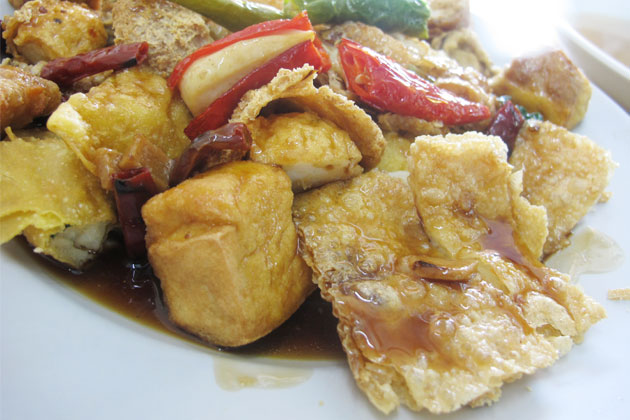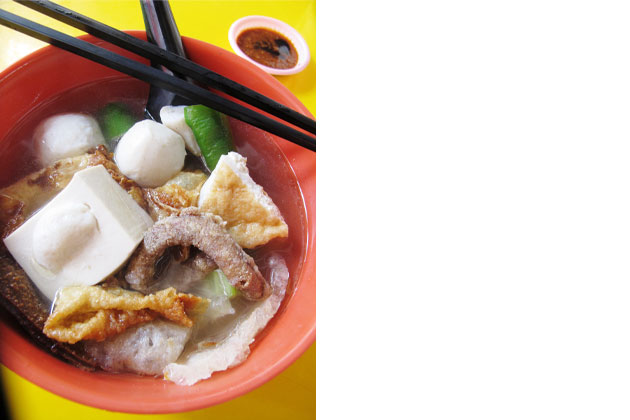
Fool Proof Yong Tau Foo
By KF Seetoh - Monday, Dec 23, 2013
Hawking Hakka Food
They were travelling nomads and gypsies who left their land in northern China in search of a better life. So they travelled south, settled, and moved on and about for centuries, till they finally found their new El Dorado in the south, in Guangdong. They were warmly welcomed by the southerners who nicknamed them the Guest People or Hakka. By then, they had infamously created a new cuisine in the course of their travels and exploits – Hakka food.
Common sense rule, and in the case of Hakka cuisine, it was very much influenced by that reality of being nomadic. They ate stuff that could last for days, sans refrigeration. They relied on the fine art of salting as a flavour agent and as a preservative. They are famous for their salt baked chicken, which is wrapped and baked in a wok of salt. The smokiness and salty aroma permeates and the meat, and the result goes so well with a bowl of rice, especially so when they hand-tear, instead of cut the fowl. No flavour is lost and texture is very agreeable. They made use of red wine lees (fermented residues) and stewed meats and seafood with it.
All of these food and more are borne out of necessity and desperation. Imagine being on the road for days on end with bad weather in tow for days without the luxury of taking a cookout or dinner break. They also made do with salted and dried vegetables. One of their famous makan exports is the mei chai kou rou, or stewed dried vegetables with fatty pork. It is a comfort classic in Singapore and many here cannot say they never had this before. The savoury and salty soft fatty pork on a bed of sweet salty stewed dried vegetables over steamed fluffy rice, to many, a childhood sensation etched in memory. Ditto for stir fried pork stomach and tripe with salted vegetables. My Hakka friends’ knees will go weak over these.
One tuber, associated closely with them is yam or taro. They steam the yam with pork belly (yes, a favourite cut for them) and they also churn out one of the most popular starches with it…abacus seeds or suan pan zi – much like yam gnocchi stir fried with dried mushrooms, minced meat, dried shrimps and Chinese sausage bits.
Then, there is their legendary Yong Tau Foo
Fool Proof Yong Tau Foo
If these nomadic Hakkas travelled across the sea further down the far east and saw what folks here did to their sacred Yong Tau Foo, they would probably faint in shock. In its original form, yong tau foo was just that “stuffed tofu”. But over the centuries and especially the last few decades, yong tau foo had taken new forms and they are still evolving. That humble piece of firm tofu was once halved, and dug out with a slot in the middle and stuffed or filled with minced fatty pork accented with salted fish powder – very robust, hardy and frontier-food in concept.
Today, if you take a look at how and where the Hakkas in Singapore and Malaysia have taken this heritage dish, it’s mind-boggling. To begin with, many now use fish paste instead of pork mince, so as to reach out to a wider audience, including the halal market. Stuffed greens like bittergourd, ladies finger or ochra, brinjal, red and green chillies, lotus roots, fried yam balls, mushrooms, dried sponge tofu and pork rinds have all been smeared with meat paste etc…they are now commonplace items in those ubiquitous food court and hawker centre stalls. This is the new age of yong tau foo and we hope these artisanal handmade pieces of food culture will never disappear from our national menu. No one should think of letting this dish slip into the shadows of history just because its labour intensive in nature and not effective nor productive in our current manpower crunch climate.
Here are three of my current favourites with differing styles:

Plum Village, 16 Jalan Leban, 11am-2.30pm/6pm-10pm, Tel: 64589005
This last of the few rare true Hakka restaurants here do it pretty much old school. No overly fancy takes like ochra or lotus root. They offer a stunning family style claypot version. It comes with just three items- stuffed firm tofu (and they stuff their meat deeper into the tofu), stuffed bittergourd and a stewed soft dried oyster wrapped in their mince pork flavoured with salted fish powder and wrapped in pig’s caul (no fish paste is used, like how it was originally). For a family sized order, do give owner Mr Lai a day’s notice.

Golden Mile Special Young Tau Foo, B1-44, Golden Mile Hawker Centre, Beach Road, 10.45am-3pm, close on Sundays.
The Chng family had been at it for over 40 years and the “Young” in their stall name does not reflect on the quality of their offerings. Probably half the ingredients, and most are meticulously handmade, are sold out 3 hours after opening. Their fish balls, though no longer made on site due to space constraints, still comes soft and has no feel of flour in it. They even fry a platter of rare pig intestines for the early birds. One of my favourites is also their stuffed chillies – it comes with enough crunch and the most of painful seeds are removed. They have an old fashion pot simmering away with “will never overcook” items like tau pok, pork skin and tofu where you pick off it. All the ingredients are fresh as turnover is high and their soup has a nice beany and fish bone taste.

Simpang Yong Tau Foo, 301 Changi Road, 9.30am-7pm, Tel: 6444 9986
Latest update: They have closed their stall for good. Let’s hope they re-open again soon.
They make it, Malaysian style. They deep fry a host of items – from stuffed crispy bean skin, chillies, ngoh hiang, meat balls, wantons, stuffed tau pok and tau kua etc…and plate them slathered with a savoury brown sauce. It just looks so enticing when it’s before you. All the items are freshly fried and comes piping hot. Only snag is, they are a tad salty but it is intended to be paired with a sweet starchy bowl of rice.


